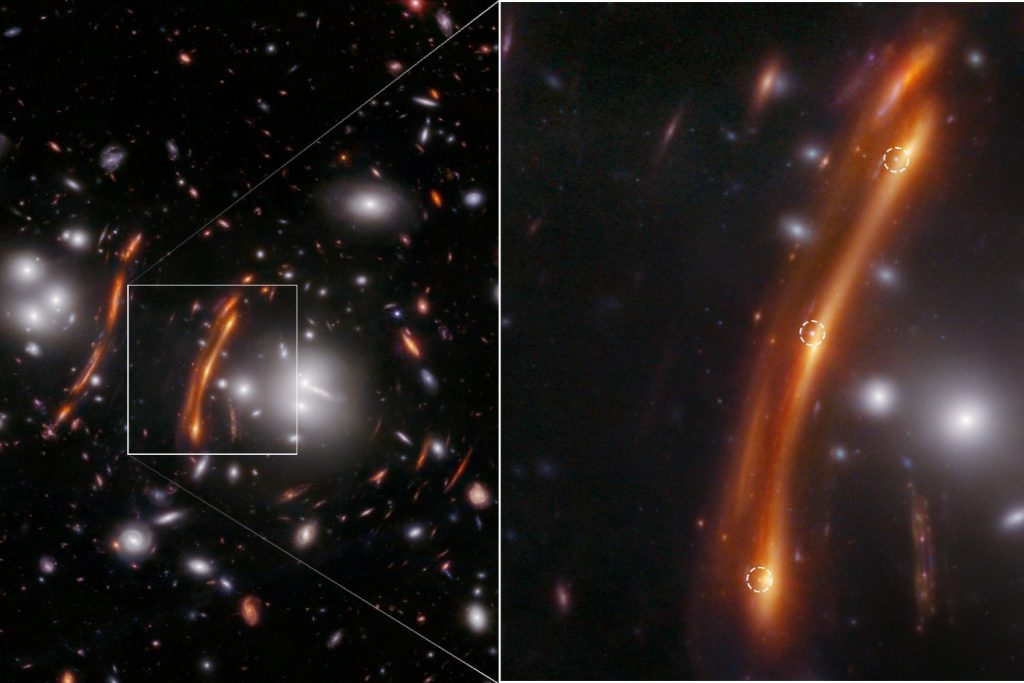
Webb Telescope Captures Supernova Appearing Three Times Due to Spacetime Bending (Image Credit: Gizmodo-com)
A remarkable image taken by the Webb Space Telescope shows the same supernova three times, thanks to a quirk of spacetime known as gravitational lensing. The image also helped the team measure the Hubble constant, a frustrating number (we’ll explain why) that represents the rate of the universe’s expansion.
Gravitational lenses are regions of spacetime where light is bent—magnified, in fact—by the mass of large structures like black holes and even clusters of galaxies. The lens explored by the recent team was created by the latter: a collection of galaxies in the constellation Ursa Major, whose collective gravitational heft bends and focuses the light from more distant sources.
By bending the light from those farther-out—and thus, more ancient—sources, the gravitational lenses make those sources easier to see from Earth (and in Webb’s case, about one million miles from Earth). This particular gravitational lens magnified a supernova—the brilliant explosion that marks the death of some stars—and multiplied it in the sky.
The galaxy cluster is named PLCK G165.7+67.0, mercifully nicknamed G165. The galaxy cluster and the supernova were imaged by the Near-Infrared Camera (or NIRCam) aboard the telescope in March, April, and May of last year. G165 is 3.6 billion light-years from Earth—a staggering distance in itself—but the supernova it highlights is even more ancient.
According to a Space Telescope Science Institute release, that region of space was chosen for imaging because of its high rate of star formation of masses more than 300 times the mass of our Sun. The region was imaged by the Hubble Space Telescope in 2015, but Webb’s infrared vision recently revealed fainter light sources in the same field.
“To achieve three images, the light traveled along three different paths. Since each path had a different length, and light traveled at the same speed, the supernova was imaged in this Webb observation at three different times during its explosion,” said Brenda Frye, an astronomer at the University of Arizona and a member of the team involved in the recent research, not all of which has been published. Several papers characterizing the supernova were published earlier this year in The Astrophysical Journal, and an upcoming paper is currently hosted on the preprint server arXiv.
The imaged galaxy cluster looks like it’s been flattened due to the gravitational lens, which warps the galaxy’s light into an arc-like shape. The arc has three specks of light stretched across it; each speck is the same supernova, lensed by the foreground galaxy cluster. It’s a similar arc-and-specks structure to the one in which a different team spotted the 12.9-billion-year-old Earendel, the oldest known star, in 2022.
Frye compared the supernova appearing three times to a person being seen from three different angles in a three-paneled vanity mirror. “In the trifold mirror analogy, a time-delay ensued in which the right-hand mirror depicted a person lifting a comb, the left-hand mirror showed hair being combed, and the middle mirror displayed the person putting down the comb,” Frye said. Though the supernova is visible in three spots simultaneously, that’s not always the case with such lensed objects. In 2016, a burst of light from a 10-billion-year-old supernova showed up in the night sky and disappeared within a few years; it was the third time the supernova, dubbed “Requiem,” showed up in the sky, as light from the event took different routes to Earth. That team of researchers said they expected more light from the supernova to arrive on Earth in 2037.
The recently three-peated supernova (or “trifold,” to use the team’s term) is more than just a charming eccentricity of spacetime. The astronomers used it to confirm the Hubble tension, a vexing headache in our understanding of the universe. The supernova was dubbed SN H0pe, for its ability to lend a hand in clarifying the nature of the tension.
The discrepancy has to do with the rate of the universe’s expansion, which the great tapestry of everything has been doing since its apparent beginning some 13.77 billion years ago. Basically, scientists get different numbers depending on the way they calculate the rate of the universe’s expansion, a figure known as the Hubble constant. One way to predict that rate is by studying the cosmic microwave background, the earliest light we can see, which dates back to about 300,000 years after the Big Bang. The other way is to look at a group of stars called the Cepheids, which are useful because they show how galaxies’ light has been stretched by the expansion of the universe.
Last year, Webb data confirmed that the Hubble tension (named for the venerated astronomer, not the telescope that also bears his name) was not due any issues with the Hubble telescope, which was previously observed to detect the tension. Two years ago this month, a different team heightened the certainty of the tension—that is to say, the certainty that the discrepancy is a scientific reality and not a statistical fluke—to a 5-sigma threshold, or a one-in-a-million chance that scientists are getting something wrong.
The next round of Webb observations will help the research team home in on the number they calculated for the tension with fewer uncertainties. That is, of course, in addition to the remarkably sharp views of the cosmos the telescope gives us.





